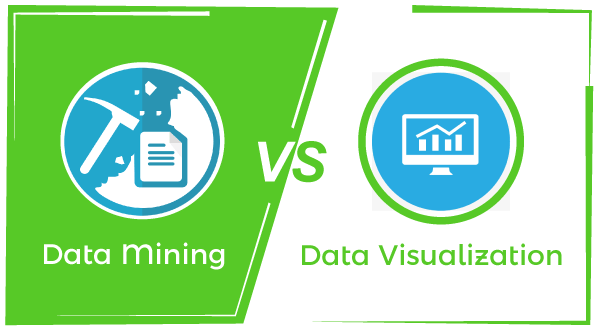Difference Between Data Mining and Data Visualization
Data Mining is all about finding useful information, patterns, and trends from raw data. Data mining is used for pattern recognition and correlation in a huge database to predict using various data mining techniques. In data mining, the extracted data is used by many companies to improve customer relationships, generate revenue, reduce risk, etc. In contrast, data visualization is the representation of data in the form of graphs, charts, or any other visual representations. Before starting the differentiation between data mining and data analysis, let’s understand the two fields separately.
What is Data Mining?
Data mining is a process of extracting potentially important information, patterns, and data from huge sets of data. Data mining is not about collecting data; it is about finding relationships in the raw data you have already collected. So, the primary purpose is to determine knowledge discovery of the collected data.
Applications of Data Mining
Data mining has broad applications. It is a technique that can be applied in almost every area. Let’s explore some important applications of data mining like marketing, sentiment analysis, and fraud detection.
Marketing:
The main objective of data mining in marketing is to help the marketing team understand the target audience (Beginner and experienced) who visit the particular website. It enables them to gather knowledge about each individual group and target them separately with customized promotions. Consider an example of a big bazaar. It targets each customer with various discounts based on the purchasing behavior of the customer.
Sentiment Analysis:
The sentiment analysis is based on text mining. It is one of the most common fields of study for data mining. It tries to catch the people’s thought process and derives their feelings.
Fraud detection:
Generally, we see the banks and financial institutions detect fraudulent activity by tracing their customer’s transactions. When a financial institution finds any suspicious transaction, the transaction will be flagged and halted for a query. Here, data mining plays a vital role in detecting and even prevent fraudulent transactions.
Data Mining Techniques
There are four most important techniques of data mining
- Finding Patterns
- Classification
- Association
- Prediction
Advantages of Data Mining
These are the following most important advantages of data mining:
- It supports decision-making.
- It helps the companies to predict the future.
- It helps the organizations to find trends, patterns in their data.
- It helps the organizations to increase revenue by using cross-selling and targeting.
What is Data Visualization?
Data Visualization refers to the visual representation of data with the help of comprehensive charts, images, lists, charts, and other visual objects. It enables users to easily understand the information within a fraction of time and extract useful information, patterns, and trends. Moreover, it makes the information easy to understand.
In other words, we can say that data representation in graphical form so that users can easily comprehend the procedure of trends in the data is called data visualization. There are many tools involved in data visualization, such as chart maps, graphs, etc. The tools used for data visualization help the users easily understand and collect the data provided by visual representation rather than going through the whole scanning the datasheets.
Importance of Data Visualization?
Data visualization represents the data in visual form. It is important since it enables information to be more easily seen. Machine learning technique plays an important role in conducting predictive analysis which helps in data visualization. Data visualization is not only helpful for business analysts, data analysts, and data scientists, but it plays a vital role in comprehending data visualization in any career. Whether we work in design, operation, tech, marketing, sales, or any other field, we need to visualize data.
Data visualization has broad uses. Some important benefits of data visualization are given below.
- Finding errors and outliers
- Understand the whole procedure
- Grasping the data quickly
- Exploring business insights
- Quick action.
Types of Data Visualization charts?
There are various tools available that help the data visualization process. Some are automated, and some are manual, but with the help of these tools, you can make any type of visualization.
Line chart: A-line chart illustration changes over time. The X-axis represents the period, whereas the y-axis represents the quantity.
Bar Chart: Bar charts illustration also change over time. In the case of more than one variable, a bar chart can make it simpler to distinguish the data for each variable at each moment in time.
Pie chart: A pie chart is one of the best options we have for illustrating algebra (percentages) because it depicts each object as part of a whole. So, if your data explain an error in percentages, a pie chart will help present the pieces in the proper proportions.
Difference between Data Mining and Data Visualization

| Data Mining | Data Visualization |
|---|---|
| Data mining is a process of extracting useful information, patterns, and trends from raw data. | Data Visualization refers to the visual representation of data with the help of comprehensive charts, images, lists, charts, and other visual objects. |
| It comes under data science. | It comes under the area of data science. |
| In data mining, many algorithms exist. | There is no need to use any algorithm. |
| It is operated with web software systems. | It supports and works better in advance data analyses. |
| It has a broad application and is primarily preferred for web search engines. | It is preferred for data forecasting and predictions. |
| It is new technology but underdeveloped. | It is more useful in real-time data forecasting. |
| It works on any web-enabled platform or with any application. | It provides visual representation, irrespective of hardware and software. |
